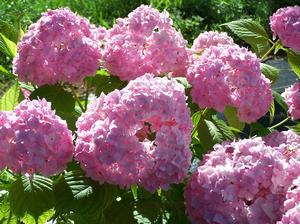
You already use botanical Latin... this is Hydrangea, Hydrangea macrophylla 'Dooley' to be specific.
Botanical Latin Made Fun
Have you ever found yourself in a situation where you embarrassedly attempted describing a plant whose name you didn’t remember while the nursery personnel’s eyes rolled up and glazed over? Knowing the correct name of the plants you have or desire in your landscape is definitely better than not knowing. Save tags. Draw maps. Learn botanical Latin. Oops! I just heard the brakes squeal. Why are you afraid of botanical Latin? It needn’t be a stumbling block. You will be surprised at how much you already know. Your eyes are about to glaze over, I know it. But stay with me: this is going to be fun.
BOTANICAL LATIN IS COOL
You already speak botanical Latin! Every time you annunciate “Hydrangea”, you have spoken Latin. Cool, huh? Consider the Spirea. The Latin spelling is Spiraea. It’s virtually the same with the addition of an “a”. Both are pronounced exactly the same. Anemone (uh-NEM-oh-nee) is the Latin name for an entire genus of beautiful herbaceous flowers, many hardy to northeast Connecticut. What about Aster, Crocus, Sedum, Daphne? You probably have all spoken the names Rhododendron, Narcissus, Magnolia and Iris? You are all so very much smarter than you give yourselves credit!
Botanical Latin is the single best method for plant identification. Common names all too often are dialectical, attached to one plant in one corner of the world and identified with a completely different plant elsewhere. It’s not a sure fire method, indeed, it can be confusing and frustrating. Botanical Latin conversely has only one name applied to one plant the world over. Begonia, Zinnia, Clivia, Trillium.
With the inclusion of an “a” in place of the “e” at the end of “Rose” you have “Rosa”. You have just adopted the Latin name of a most popular genus of flowering shrubs. In either case, be they Rose or Rosa, both are lovely women names. Say “Melissa” out loud. Go on, don’t be bashful… Melissa is the botanical Latin name for Lemon Balm. Erica is the Latin for Heath. Add an “um” and remove the “e” from the end of Jasmine and out comes Jasminum (jaz-MYN-uhm). Pretty cool, heh? Attach an “ium” to Helen. Helenium (heh-LEE-nee-uhm) is “Helen’s Flower” or “Sneezeweed” depending upon where you live.
How about the boys? Add an “ia” to David and you conjure up Davidia, commonly called the Handkerchief Tree or Dove Tree. Stewart merged with “ia” becomes Stewartia. Sometimes called Northern Crepe Myrtle, Stewartia is smart shorthand as there are now some Crepe Myrtles (Lagerstroemia) that are being bred for added cold hardiness. Henceforth they are extending their range into more northerly gardens. Stewartia will never be confused with Lagerstroemia. But communication breakdown could come easily from using the misnomer Northern Crepe Myrtle.
SAY IT OUT LOUD
Lobelia. Monarda. Hosta. Campanula. Did you hear that? You just spoke Latin. You’re amazing! Amaranthus. Gladiolus. Pachysandra. Forsythia. Astonishing! Add an “us” at the end of “Juniper” and you have Juniperus. Look at you, smarty pants – you just spoke Latin again! Worried about the pronunciation and where to place the accent? Simple: it’s: joo-NIP-er-us. Say it out loud once or twice. You did it again: you are brilliant! Remove the “e” from Lupine. Add an “us” in its place. What do you have? Lupinus. Say “pine” out loud. Remove the “e”. Add an “us”. Now, say “Pinus”. You’re on a roll. Put a “car” in front of “pinus” and you get Carpinus which is the correct name for the Hornbeams. Carpinus. Pronounce it. Embrace it.
BE BOLD
Let’s try a few more. Yucca. Yucca is related to Agave (uh-GAH-vay). Agave is the botanical Latin name for a beautiful succulent genus. If I ever introduce an Agave, I think I’ll call it Agave ‘Maria’. HAH! See: this can be fun, too. What about Geranium, Phlox, Delphinium and Dianthus? See: you already employ an extensive botanical Latin vocabulary. Don’t be intimidated by Latin names; many slide easily off the tongue. The more you embrace botanical Latin nomenclature the easier it becomes. Do you grow Jeffersonia, Celosia, Viola or Viburnum? With all the names you already have under your belt this should give you footing and impetus to grow your vocabulary. Remember: botanical Latin identifications are the best single way to communicate the specific plant of which you speak to another person no matter where in the world you might be. And remember: it’s not the pronunciation that’s important – it’s the communication that’s of import. You needn’t ever be ashamed or embarrassed for trying. Never! Nursery owners will applaud your courage and be filled with gratitude. You’ll astonish your friends. You’ll become an inspiration and a role model to all those gardeners in your life. You’ll be filled with well-earned pride. Botanical Latin… Be bold. Embrace it. Get used to it.
Penned by Wayne Paquette in January, 2007